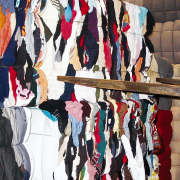The Global Textile Recycling Market
As per the latest research report published by Extrapolate, the global Textile Recycling Market is expected to grow to 9.89 billion US-Dollar by 2032, with a compound annual growth rate (CAGR) of nearly 4.3 percent between 2023 and 2032. In 2022, it was valued at 6.45 billion US-Dollar.
The growing environmental concern about waste production and rising social awareness about textile recycling, would propel the textile recycling market growth, the market research company, headquartered in the United Arab Emirates, emphasized. Textile recycling has several environmental and economic benefits, including reduced land and water pollution, reduced reliance on virgin fibers, reduced use of chemical dyes, and optimal energy and water consumption. It has also recently emerged as an effective method for sustainable development in the apparel industry.
Trends
However, this global market is relatively small and in a developmental phase; it is fragmented, with an increasing number of small-scale key players, Extrapolate informed. “To increase revenue generation and market share, key players have adopted several business strategies such as technological development, expansion, and mergers and acquisitions.”
The Regions for Green Textiles (RegioGreenTex) project’s 43 partners met in Brussels to kick off a three-year project that could change how textile recycling is managed, the company reported. The undertaking would help small and medium-sized enterprises (SMEs) turn textile waste into valuable resources. “RegioGreenTex is a quadruple-helix partnership initiative aimed at mapping and reducing the challenges that currently exist in the implementation of a circular economy model within the textile ecosystem across the European Union (EU), according to a press release from the European Apparel and Textile Confederation (EURATEX).”
Growing Awareness
Consumers’ awareness of textile recycling has grown due to government and non-profit initiatives. On account of rising awareness, there has been a significant increase in the donation and collection of waste textiles, which fuels the global recycled textile market. The business saves a lot of money by using recovered textiles. “In addition, recycled textiles are significantly less expensive than virgin materials,” Extrapolate stated. Furthermore, virgin materials are not always readily available, delaying production and impacting overall manufacturing costs; thus, switching to recycled textiles is advantageous. Moreover, recycled textiles such as wool, cotton, and polyester would require less and simpler processing, which increases the demand for recycled textiles. Asia Pacific is the largest market for textile recycling owing to several factors such as the strong industrial base, depletion of raw materials, awareness of the environmental impact of waste, and heavy industrial discharges from mills.
North America is expected to grow at the fastest CAGR and contribute significantly to the textile recycling market’s growth, the company announced. “The United States produces the majority of the textile waste in the region. As a result, organizations that reuse or recycle used clothing are likely to drive the recycled textile market. Furthermore, rising government and consumer awareness is expected to spur market growth. As a result, the number of reused textiles is substantial, while textile waste generation is low.”
extrapolate.com/enquire/retail/textile-recycling-market/87502
(Published in GLOBAL RECYCLING Magazine 3/2023, Page 3, Photo: Fotoschlick / stock.adobe.com)








